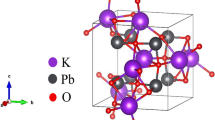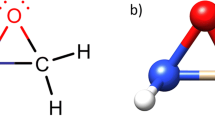Abstract
Segmented all-electron basis sets of double and triple zeta valence qualities plus polarization functions (DZP and TZP) for the elements Fr, Ra, and Ac to be used with the zeroth-order regular approximation (ZORA) were presented. These sets were constructed from the reoptimization of the contraction coefficients of the corresponding non-relativistic basis sets. In order to adequately describe electrons distant from the atomic nuclei, these sets were augmented with diffuse functions and were, respectively, designated as ADZP-ZORA and ATZP-ZORA. At the ZORA-B3LYP theory level, the relativistic sets were employed to calculate ionization energies of Fr, Ra, and Ac as well as bond lengths, dissociation energies, harmonic vibrational frequencies, and static mean dipole polarizabilities of some diatomics. Comparing with benchmark theoretical results and with experimental data available in the literature, it can be verified that our basis sets are able to produce reliable and accurate results. Evaluation of the performances of ZORA and second-order Douglas-Kroll-Hess Hamiltonians was performed.
Similar content being viewed by others
Data availability
Not applicable.
References
Pyykkö P (1988) Relativistic effects in structural chemistry. Chem Rev 88:563
Zerner MC, Salahub D (1989) The challenge of d- and f-electrons. American Chemical Society, Washington
Kaltsoyannis N, Hay PJ, Li J (2006) Blaudeau, J.P., Bursten, B.E.: The chemistry of the actinide and transactinide elements. Morss LR, Edelstein N, Fuger J (Eds.), 3rd edn. Springer, Dordrecht
Dolg,M (2000) Effective core potentials. In Modern methods and algorithms of quantum chemistry. Grotendorst J (Ed.), 2nd edn. John von Neumann Institute for Computing. Jülich 3
Frenking G, Antes I, Böhme M, Dapprich S, Ehlers AW, Jonas V, Neuhaus A, Otto M, Stegmann R, Veldkamp A, Vyboishchikov SF (1996) Pseudopotential calculations of transition metal compounds: scope and limitations. Rev Comp Chem 8:63
Güell M, Luis JM, Solà M, Swart M (2008) Importance of the basis set for the spin-state energetics of iron complexes. J Phys Chem A 112:6384
Vyboishchikov SF, Sierraalta A, Frenking G (1997) Topological analysis of electron density distribution taken from a pseudopotential calculation. J Comput Chem 18:416
Cirera J, Ruiz E (2008) Exchange coupling in CuIIGdIII dinuclear complexes: a theoretical perspective. C R Chim 11:1227
Douglas M, Kroll NM (1974) Quantum electrodynamical corrections to the fine structure of helium. Ann Phys (NY) 82:89
Hess BA (1985) Applicability of the no-pair equation with free-particle projection operators to atomic and molecular structure calculations. Phys Rev A 32:756
Hess BA (1986) Relativistic electronic-structure calculations employing a two-component no-pair formalism with external-field projection operators. Phys Rev A 33:3742
Van Lenthe E, Baerends EJ, Snijders JG (1993) Relativistic regular two-component Hamiltonians. J Chem Phys 99:4597
Jorge FE, Canal Neto A, Camiletti GG, Machado SF (2009) Contracted Gaussian basis sets for Douglas–Kroll–Hess calculations: estimating scalar relativistic effects of some atomic and molecular properties. J Chem Phys 130:064108
Barros CL, de Oliveira PJP, Jorge FE, Canal Neto A, Campos M (2010) Gaussian basis set of double zeta quality for atoms Rb through Xe: application in non-relativistic and relativistic calculations of atomic and molecular properties. Mol Phys 108:1965
de Berrêdo RC, Jorge FE (2010) All-electron double zeta basis sets for platinum: estimating scalar relativistic effects on platinum(II) anticancer drugs. J Mol Struct THEOCHEM 961:107
Canal Neto A, Jorge FE (2013) All-electron double zeta basis sets for the most fifth-row atoms:application in DFT spectroscopic constant calculations. Chem Phys Lett 582:158
Campos CT, Jorge FE (2013) Triple zeta quality basis sets for atoms Rb through Xe: application in CCSD(T) atomic and molecular property calculations. Mol Phys 111:167
Martins LSC, Jorge FE, Machado SF (2015) All-electron segmented contraction basis sets of triple zeta valence quality for the fifth-row elements. Mol Phys 113:3578
Baykova SV, Semenova AV, Presnukhinaa SI, Novikova AS, Shetnev AA, Boyarskiy VP (2022) Hydrogen vs halogen bonding in crystals of 2,5-dibromothiophene-3-carboxylic acid derivatives. J Mol Struct. 260:132785
Grudova MV, Novikov AS, Kubasov AS, Khrustalev VN, Kirichuk AA, Nenajdenko VG, Tskhovrebov AG (2022) Aurophilic interactions in cationic three-coordinate gold(I) bipyridyl/isocyanide complex. Curr Comput-Aided Drug Des 12:613
Mironova AD, Mikhaylov MA, Maksimov AM, Brylev KA, Gushchin AL, Stass DV, Novikov AS, Eltsov IV, Abramov PA, Sokolov MN (2022) Phosphorescent complexes of {Mo6I8}4+ and {W6I8}4+ with perfluorinated aryl thiolates featuring unusual molecular structures. Eur J Inorg Chem 2022:e202100890
De Almeida CA, Pinto LPNM, dos Santos HF, Paschoal DFS (2021) Vibrational frequencies and intramolecular force constants for cisplatin: assessing the role of the platinum basis set and relativistic efects. J Mol Model 27:322
Roos BO, Veryazov V, Widmark P-O (2004) Relativistic atomic natural orbital type basis sets for the alcaline and alkaline-earth atoms applied to the ground-state potentials for the corresponding dimers. Theor Chem Acc 111:345
Roos BO, Lindh R, Malmqvist P-A, Veryazov V, Widmark P-O (2005) New relativistic ANO basis sets for actinide atoms. Chem Phys Lett 409:295
Te Velde G, Bickelhaupt FM, Baerends EJ, Fonseca Guerra C, van Gisbergen SJA, Snijders JG, Ziegler T (2001) Chemistry with ADF. J Comput Chem 22:931
Hill JG, Peterson KA (2017) Gaussian basis sets for use in correlated molecular calculations. XI. Pseudopotential-based and all-electron relativistic basis sets for alkali metal (K-Fr) and alkaline earth (Ca-Ra) elements. J Chem Phys. 147:244106
Feng R, Peterson KA (2017) Correlation consistent basis sets for actinides. II. The atoms Ac and Np–Lr. J Chem Phys. 147:084108
Campos CT, de Oliveira AZ, Ferreira IB, Jorge FE, Martins LSC (2017) Segmented all-electron Gaussian basis sets of double and triple zeta qualities for Fr, Ra, and Ac. Chem Phys Lett 675:1
Pantazis DA, Neese F (2011) All-electron scalar relativistic basis sets for the actinides. J Chem Theory Comput 7:677
Canal Neto A, de Oliveira AZ, Jorge FE, Camiletti GG (2021) ZORA all-electron double zeta basis sets for the elements from H to Xe: application in atomic and molecular property calculations. J Mol Model 27:232
Centoducatte R, de Oliveira AZ, Jorge FE, Camiletti GG (2022) ZORA double zeta basis sets for fifth row elements: application in studies of electronic structures of atoms and molecules. Comput Theor Chem 1207:113511
Canal Neto A, Ferreira IB, Jorge FE, de Oliveira AZ (2021) All-electron triple zeta basis sets for ZORA calculations: application in studies of atoms and molecules. Chem Phys Lett 771:138548
Jorge FE, Canal Neto A (2020) A new method for optimizing a set of nonlinear parameters: application in total Hartree-Fock atomic energy calculations. Theor Chem Acc 139:76
Neese F (2012) The ORCA program system. Wiley Interdiscip Rev Comput Mol Sci 2:73
de Jong WA, Harrison RJ, Dixon DA (2001) Parallel Douglas-Kroll energy and gradients in NWChem: estimating scalar relativistic effects using Douglas-Kroll contracted basis sets. J Chem Phys 114:48
Kramida A, Ralchenko Yu, Reader J, and NIST ASD Team (2021) NIST Atomic Spectra Database (ver. 5.9), [Online]. Available: https://physics.nist.gov/asd [2022, July 25]. National Institute of Standards and Technology, Gaithersburg, MD
Lim IS, Schwerdtfeger P, Söhnel T, Stoll H (2005) Ground-state properties and static dipole polarizabilities of the álcali dimers from to ( = 0, +1). from scalar relativistic pseudopotential coupled cluster and density functional studies. J Chem Phys 122:134307
Hong G, Dolg M, Li L (2001) A comparison of scalar-relativistic ZORA and DKH density functional schemes: monohydrides, monooxides and monofluorides of La, Lu. Ac and Lr Chem Phys Lett 334:396
Küchle W, Dolg M, Stoll H (1997) Ab initio study of the lanthanide and actinide contraction. J Phys Chem A 101:7128
Laerdahl JK, Faegri K, Visscher L, Saue T (1998) A fully relativistic Dirac–Hartree–Fock and second-order Möller-Plesset study of the lanthanide and actinide contraction. J Chem Phys 109:10806
Konings RJM, Beneš O, Kovács A, Manara D, Sedmidubský D, Gorokhov L, Iorish VS, Yungman V, Shenyavskaya E, Osina E (2014) The thermodynamic properties of the f-elements and their compounds Part. 2. The lanthanide and actinide oxides. J Phys Chem Ref Data 43:013101
Funding
We would like to acknowledge the financial support of Conselho Nacional de Desenvolvimento Científico e Tecnológico (Brazilian Agency).
Author information
Authors and Affiliations
Contributions
All authors contributed equally to the work.
Corresponding author
Ethics declarations
Competing interests
The authors declare no competing interests.
Conflict of interest
The authors declare no competing interests.
Additional information
Publisher's note
Springer Nature remains neutral with regard to jurisdictional claims in published maps and institutional affiliations.
Rights and permissions
Springer Nature or its licensor holds exclusive rights to this article under a publishing agreement with the author(s) or other rightsholder(s); author self-archiving of the accepted manuscript version of this article is solely governed by the terms of such publishing agreement and applicable law.
About this article
Cite this article
Neto, A.C., Jorge, F.E. & Gomes, T. ZORA Gaussian basis sets for Fr, Ra, and Ac. J Mol Model 28, 334 (2022). https://doi.org/10.1007/s00894-022-05331-4
Received:
Accepted:
Published:
DOI: https://doi.org/10.1007/s00894-022-05331-4




